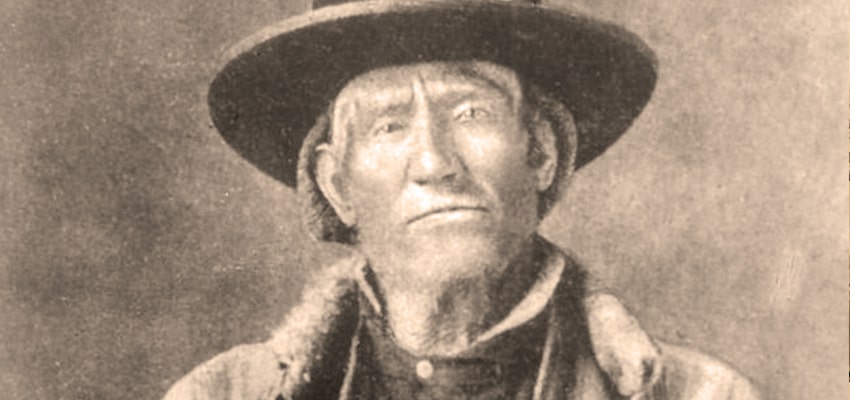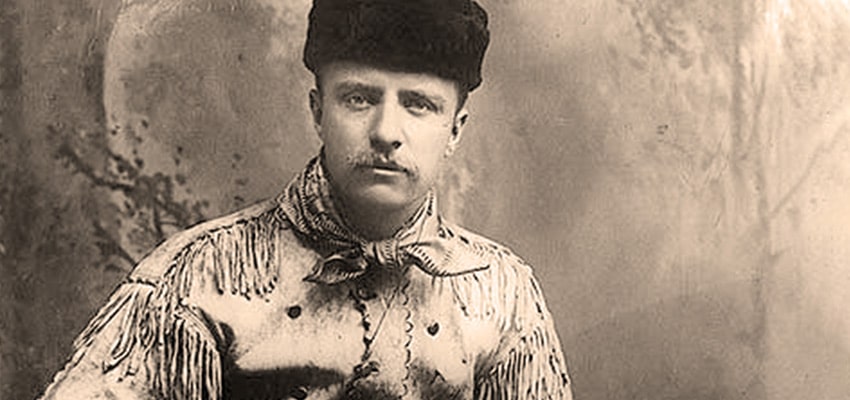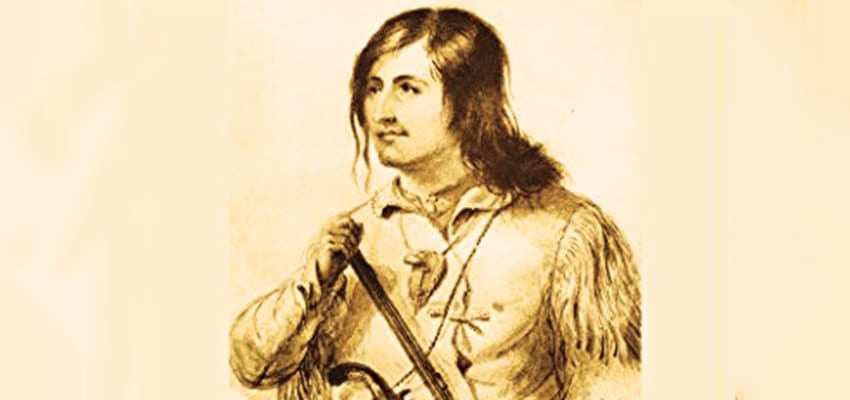A vacation in the Rocky Mountains is a magnificent adventure. While you’re there, consider the people who came to that uncharted territory in the 19th century, the Mountain Men. They were French Canadians, Blacks, and Whites who left society behind to explore a vast, unknown landscape. They witnessed an earth that roiled and bubbled and erupted even when the skies were snow-filled. (Imagine coming upon Yellowstone’s geysers!) Follow in the steps of those wide-eyed dreamers.
Jedediah Smith
Smith looked at a map of the West when most of it was marked Unexplored. He set out to map every foot of it—which he did. First, he led an outfit to the mountains of western Wyoming, on the way getting one ear torn off by a grizzly bear. Then he found South Pass, the best route across the Rockies. He crossed the Mojave Desert to California, then rode to Oregon and back across the mountains.
On beaver hunts he went again and again to the headwaters of the South Platte, near the present Fairplay, Colorado. Fairplay is known today as the place “Where History Meets the High Country.”
Jim Bridger
Bridger was a man of the Rocky Mountains from first to last. At the age of eighteen, recently orphaned, he rode on the first expedition of fur trappers to the Rocky Mountains, up the South Platte River into the Rockies. This country became the favorite trapping grounds of the mountain men. The next year Jim rode down a river into the Great Salt Lake, tasted its waters, and declared that he had arrived at the Pacific Ocean.
Soon known as Old Gabe, Jim proceeded to become an owner of the Rocky Mountain Fur Company and to guide emigrants across the Oregon Trail to the Far West. Late in life, he founded Fort Bridger in southwestern Wyoming.
Jim Beckwourth
Beckwourth was both Black man and White, the son of an Irish aristocrat and a slave woman. In 1824 he rode west with a trapping expedition. He began a new life as a mountain man that was fabled, mostly by the tales he told about himself in the autobiography he dictated.
He was at the first Rendezvous celebration on the Green River in 1825, wintering that year with Jedediah Smith in the Cache Valley, along the gorgeous border of today’s Utah and Idaho. Beckwourth was so thoroughly the master of the tall tale that he spun one about running 95 miles in a single day. His autobiography sold well!
Jean-Babtiste Charbonneau
Charbonneau was born high on the Missouri River, son of Toussaint Charbonneau and his wife Sacajawea. She led the Lewis and Clark expedition up the Missouri, across the Rocky Mountains, and down to the western sea, giving birth to Baptiste along the way. From that beginning, the young man put together an amazing life: After growing up and being educated in St. Louis, Baptiste was invited by Prince Paul of Württemberg to come live in his castle near Stuttgart, Germany.
During the next six years, Baptiste learned French, German, Spanish, and courtly manners. Then the young man made an amazing choice: He went back to his homeland, became a fur trapper, and spent the rest of his life trapping beaver and panning for gold. Charbonneau truly was a man of two worlds.
Hugh Glass
Glass, subject of the award-winning movie The Revenant, was headed for the country of the Yellowstone River, heart of the mountains, when a grizzly mauled him. His companions, certain Glass would die, left him with two men to bury the body and bring away his rifle. But these companions, John Fitzgerald and the young Jim Bridger, didn’t wait for death. They took Hugh’s rifle and skedaddled.
Hugh woke up to three hells: He was badly hurt, he had no gun to get food, and he was crazy with rage at being abandoned.
Unable to walk, Hugh crawled downriver toward the Missouri, surviving on berries and carcasses left by wolves, and driven by a lust for revenge. After an epic chase around the mountains, he caught up with the guilty men. Fitzgerald eluded him, but Hugh faced Bridger, looked inward at the heat of his cooling rage, and said, “For your youth I forgive you.” His story is written in the Rocky Mountains.
Joe Meek
Meek headed for the mountains and the wild life in 1829 with William Sublette. Joe went to the Rendezvous in Pierre’s Hole, on the west side of the Tetons, then trapped the stretch of mountains from the Snake River to southern Utah. Two marriages to Indian women ended in two tragedies: A band of Bannock Indians killed his first wife, and his second wife was murdered while trapping with him in the Tetons.
Meek longed for new lands to explore and needed a new beginning. He moved to Oregon, had three children with his third Indian wife, became a politician, and spun tall tales into a best-selling book about his remarkable life.
Jim Clyman
Clyman headed up the Missouri River to the wild West in 1823 and right into trouble. The Ree Indians attacked the party and drove it back down the river. Clyman ran for his life and made a narrow escape. Travelling with Jedediah Smith, he helped discover the fine trapping territory of the upper Green River. But he got separated from his outfit and had to walk 700 miles down the Platte River to Fort Atkinson on the Missouri.
Clyman, born on a farm that belonged to George Washington, spent two years trapping the mountains around the Great Salt Lake. (He ran into the Donner party and told them to change their route—they didn’t take his advice.) Clyman struck out farther west, married, settled in California’s Napa Valley, and lived to a hearty, old age. During all those years Clyman kept a log of his adventures, which he published as Journal of a Mountain Man.
The Mountain Men explored the Rockies for only a short time, not overpowering Native Americans, but trading with them, marrying Indian women, and having families. Many ended up moving to Northern California where their mixed-race children were accepted. For more about them, check Win Blevins’s NY Times bestseller Give Your Heart to the Hawks.
 My Trips
My Trips 
















